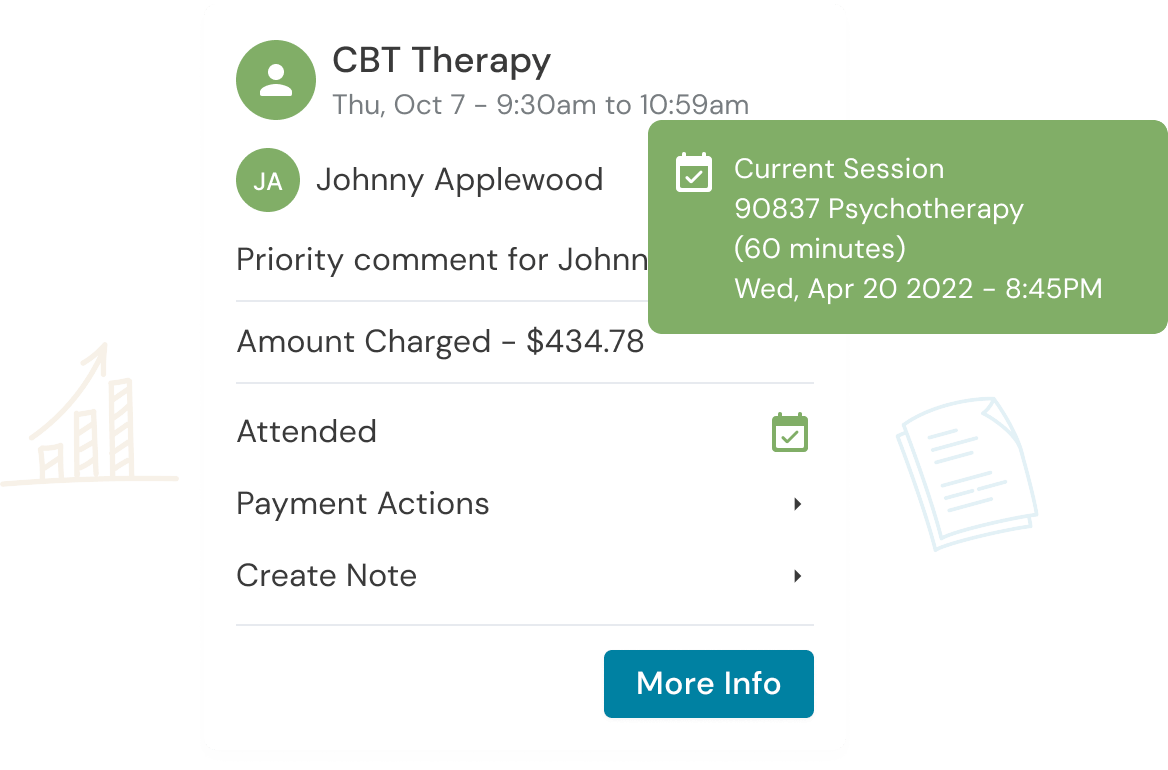Therapists in private practice benefit from being self-employed, and many of them start their private practice because of the freedom. Setting your own schedule, getting full reign over practice direction, and being your own boss are just a few reasons why therapists choose to go into private practice.
When running a private practice, no one else is going to plan for your retirement but you. By having a plan — even decades before you’re ready to retire — can help set you up for a relaxing, enjoyable, and meaningful post-work life.
Read on for Zencare’s top tips for retirement planning for therapists in private practice.

Benefits of setting up a retirement plan for your therapy practice
Retirement planning has many benefits, especially for therapists. Compared to some other small businesses, therapists continue to have responsibility to their clients even after they retire. This means that retirement planning must include considerations about how to ensure that all clients are taken care of, leaving you with peace of mind so you can enjoy your hard-earned retirement.
Most importantly, retirement planning benefits therapists because it provides them with financial security. By following some small business retirement tips, you’ll be able to take advantage of tax deferrals and pick the right retirement plan for you, such as a 401(k) or IRA. You’ll also have back-up funds in case there’s an emergency, as many retirement plans allow for withdrawing funds should you fall into hardship.
Choosing a retirement plan that’s best for you and your practice
In the US, there are several types of retirement plans, all with their own benefits and disadvantages. It’s important to understand your options and to think through what makes the most sense for your situation, as being thoughtful about your decision can mean thousands of dollars of difference by the time that you’re ready to retire.
Things to consider when choosing a retirement plan
When choosing a retirement plan, here are a few important considerations:
- Is your practice a solo endeavor or a group practice? If you’re the only therapist at your practice, you’ll only have your own retirement to think about. However, if you employ other therapists, then you may want to offer them retirement benefits, which will have budget implications for your practice.
- What is your annual income? Therapists’ annual income spans a wide range, and different retirement account types benefit each end of the spectrum. For example, some therapists may want to maximize their take-home pay to cover expenses in the present, while others may want to put more money towards retirement to maintain their lifestyle once they stop working.
- When do you want to pay taxes? One of the ways retirement accounts differ comes from the timing on when you pay taxes — more on this below. Some people find it helpful to pay taxes when withdrawing from their retirement funds, as they pay less in a lower tax bracket. It’s best to consult with a tax accountant to determine when the best time is for you to pay taxes on your retirement savings.
- What are your goals for retirement? When thinking about your goals for retirement, consider whether you need to have just enough money to cover living expenses or if you would like a larger amount of money for expenses like travel, new cars, and more.
- What does the timing look like for your retirement? If your retirement is in a few years, your retirement planning will look quite different than if your retirement is in a few decades. Imminent retirement means that you’ll likely need to select a retirement plan that is most beneficial for saving in the short term. You’ll also need to decide if you’ll retire all at once or if you’ll slowly taper off, keeping your practice open but reducing the number of clients you see each week until you’re at a comfortable level.
- Are you open to continuing to work for income after you retire from your private practice? Closing your private practice and retiring as a therapist doesn’t necessarily mean that it’s the end of the road for your career. Many therapists take up consultant work or explore other areas of employment to continue to have income even after they stop clinical work. If this is something that you’re interested in, then you’ll likely need less retirement savings to make ends meet.
By thinking through the above, you’ll gain a more multidimensional understanding of what you’ll need to account for in your retirement planning.
Retirement plans for solo practices
Some of the more common retirement plans include 401(k)s, IRAs, and pensions (though pensions are hard to come by these days). For the self-employed, like therapists in private practice, certain retirement plans make more sense.
One of the important distinctions when retirement planning is the difference between a “traditional” account and a “Roth” account. This distinction exists for both 401(k)s and IRAs. When you have a traditional retirement plan, your money is deposited into the account directly from your pre-tax paycheck, which means that you’ll need to pay taxes on that money when you withdraw it from your retirement savings. For Roth accounts, you invest post-tax dollars into your account so that by the time you’re ready to use your retirement savings, there’s no need to pay taxes on it.
- 401(k) Retirement Plans — These are a popular retirement plan offered by many employers to put a portion of an employee’s salary into retirement savings. Sometimes, employers match these contributions to help their employees reach healthy retirement savings. Individuals can access this money, which will have compounded over time, when they reach the age of 59 ½. A solo 401(k) is a great retirement account type for therapists, as it was created for small business owners and has more realistic eligibility criteria for those who are in private practice.
- Individual Retirement Accounts (IRAs) — This retirement plan also allows withdrawals at age 59 ½. Besides the traditional IRA and the Roth IRA, there is also the Simplified Employee Pension (SEP) IRA. In a SEP IRA plan, an employer can make contributions into an employee’s IRA to help them reach their retirement savings goals. This may be a good option for private practice owners who employ other therapists and want to provide them with retirement benefits — more on this in the next section.
Retirement plans for therapists with group practices
Another way for a private practice owner to provide their team with retirement benefits is called a Savings Incentive Match Plan for Employees (SIMPLE) IRA. In a SIMPLE IRA, employers make contributions into their employee’s IRA accounts matching the amount that the employee contributes. If an employee puts $200 a month into their IRA, their employer will also contribute $200 a month. For the employee, these contributions are tax deductible, which can make a huge difference in their finances during tax season and mean more take-home pay in the present.
When it comes to employer contributions to retirement accounts, employers can make either matching contributions like above or non-elective contributions. A non-elective contribution is a set amount placed into an employee’s account no matter if the employee contributes.
How to prepare your clients for your retirement
Besides getting your personal finances up to standard to ensure peace of mind, when it comes to retirement from private practice, it’s also important to prepare your clients for your departure. For those who are getting close to retirement, it’s necessary (and ethical) to provide your clients with at least 60 days of notice. It’s important to also inform former clients, as they might reach out to you for additional sessions in the future or want to know what’s happening with their records.
When sharing the news of your upcoming retirement, you’ll have the opportunity to engage your clients in conversations about their futures and their mental health goals. It’s a natural time for them to reflect on what they want to get out of therapy, and if they’re searching for a new therapist, what to look for in terms of specialization, approach, or identity. Zencare’s therapist directory can help individuals, couples, and families find a good fit for them through the extensive search logic and filters — you can even take your client through the directory to help them find a few therapists to reach out to for free consultation calls.
What to do about new referrals after retirement
If you have therapist profiles set up across various marketing platforms, you may continue to receive referrals even after you’ve retired. To avoid this, there are a few things you can do so therapy-seekers aren’t left hanging:
- Make sure that all your subscriptions and marketing resources have been cancelled.
- Add notes to your profiles that you are no longer taking referrals. That way, if a prospective client finds your profile and wants to reach out, they can clearly see that you’re no longer practicing.
- Set up an automated reply to your email noting your retirement or record a message on your voicemail sharing the news.
If a referral somehow does make its way to you, you might also consider sharing these referrals with colleagues or other therapists in your area. If you continue to receive inquiries from prospective clients, then it can be helpful to give them a list of other therapists that are taking referrals.
Taking care of administrative details after retirement
When it comes to therapy practices, you never know when you’ll need your records. Keeping Protected Health Information (PHI) indefinitely may seem tedious, but having access to your case notes may be required should your former clients (or their legal teams) need them in the future. You might even consider asking your malpractice insurance company whether you can switch to a “tail” plan that covers you for malpractice suits after you’ve retired.
You’ll also need to register your National Provider Identifier (NPI) number as inactive, as well as cancel your membership to any professional organizations should you no longer want to be involved or maintain your license. While the administrative details may seem overwhelming, each one that you cross off your to-do list means you’re one step closer to retirement.
Summary
Retirement is an exciting time, a time that — with financial resources — is filled with joy and fulfillment. By planning your retirement from therapy in advance, you’ll give yourself a step up in achieving a comfortable retirement. This way, you can take well-earned rest and refocus yourself around new hobbies, passions, and endeavors.
The thing about retiring from therapy is that you’ll always be a therapist. While you might not practice or you might give up your credential, your ability to help others and your capacity for empathy and kindness doesn’t cease. Retirement is an employment status, but to us at Zencare and all of your former clients, you’ll always be an amazing therapist.

Get paid with Owl Practice.
Reduce clinical administrative tasks and transform more lives with Owl Practice. Owl Practice provides all the tools you need to make your practice successful. Join the thousands of care professionals using Owl to run their practice every day.



